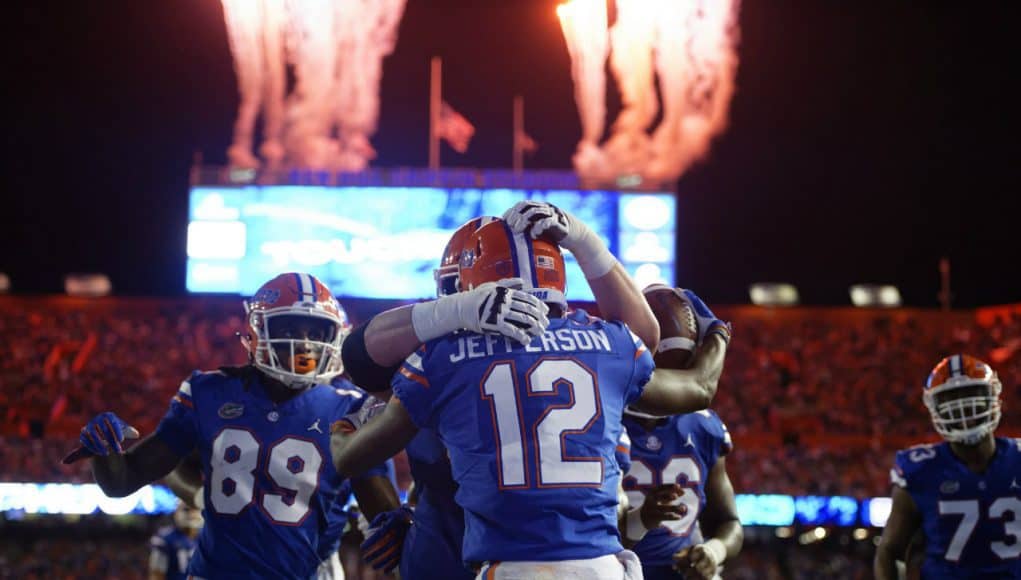In press availability yesterday, some of Florida’s offensive players talked about wanting to push the pace with the offense this fall.
One thing the writeup I linked to mentions is that Florida was 91st in plays per game last year. That implies a fairly leisurely offense.
Plays per game is not a great measure of pace, however. About a decade ago it wasn’t a bad proxy since few teams really wanted to crank up the tempo. When only a handful of teams do that, they really stick out. Now that many teams play with pace, it’s less useful.
A better measure of pace is seconds per play. You take time of possession divided by total plays run to see approximately how much time elapsed between plays. It’s not perfect because of how the clock stops, so a team that throws a lot of incompletions will show as having a faster pace than perhaps it should. However, a lot of that evens out over the course of the season.
I looked at the SEC for 2018, and Florida was sixth in taking 26.2 seconds per play. Even that raw number won’t tell you the whole story, as the conference is better described in tiers rather than a 1-14 order.
The fastest tier was South Carolina (21.9 seconds per play) and Ole Miss (22.6). The next tier was Missouri and Auburn between 24 and 25 seconds per play. Then came LSU, Florida, Arkansas, Alabama, and Texas A&M between 26 and 27.5 seconds per play. The slowest tier was Vandy, Georgia, Kentucky, Mississippi State, and Tennessee at 28.5 to 29.3 seconds per play.
How much a team possesses the ball makes a difference in these two measures. South Carolina was the fastest team in the league by seconds per play, but it was seventh in plays per game because it tended to have short drives and averaged just under 25 minutes of possession per game. Another big discrepancy came from Texas A&M being ninth (the tail end of the middle tier) in seconds per play but second in the SEC in plays per game. The Aggies led the conference by chewing up almost 34 and a half minutes of possession per game, around two and a half minutes more than second place LSU.
Florida, for its part, was sixth in both measures. It probably should have been a little higher in plays per game, though. The Gators only ran 44 plays against Colorado State and 53 against Tennessee in part because of non-offensive scores and quick strikes. They had a blocked punt for a touchdown and a punt return touchdown plus four scoring drives of four plays or less against the Rams. A week later they had five drives of two (!) plays or less (four scoring) against the Vols. In the former case as well, the defense had a hard time getting off the field with CSU having four drives of at least nine plays.
ESPN’s Bill Connelly has an adjusted pace stat that takes a team’s tempo as measured by seconds per play and normalizes it based on the pace you’d expect from its run/pass mix. This stat takes care of the clock stoppage issue I mentioned above. UF was 61st in that a year ago, just a hair faster than the national average. The offense wasn’t zippy, but it also wasn’t intentionally glacial in its pace as some Muschamp and McElwain attacks were.
So what did the Florida players actually say about pace?
Van Jefferson said a higher speed will be possible from guys being more well-versed in the offense. Kyle Trask spoke of packages specifically designed for rapid play execution “to catch the defense off balance”. Tyrie Cleveland said the goal specifically was to score faster; “get on the field and get off” was the way he described it.
Each of these are pieces that together make a coherent whole. It is easier to pick up the pace and remain successful if players know the playbook better as Jefferson said. Trask and Cleveland then spoke of two advantages to hurrying things up, which are possibly confusing defenses and becoming more explosive.
Cleveland didn’t say they’d try to hit more big plays, but it’s hard to get off the field quickly without them. If you average five yards per play, it’ll take you 16 plays to go 80 yards for a score after a punt touchback. Even if you go at South Carolina’s breakneck pace from a year ago, that’ll still take about six minutes off the clock and consume up to 40% of a quarter’s timespan.
Improving explosiveness is a key for this year, and aiming to catch defenses off balance with tempo is not a bad way to go about it. Having versatile players like Kadarius Toney, Lamical Perine, and Jacob Copeland who can credibly line up in the backfield, go out wide, and even take direct snaps gives Mullen a lot of options without needing to take up time with substitutions. And, of course, the offense not substituting prevents the defense from being able to do substitutions unless they want to get caught with either something like ten or 14 players on the field a the snap.
If Florida can use tempo to its advantage, you’ll definitely feel it in the game. You’ll also need to be careful about how you look to measure it. Reducing the number of seconds per play is upping the pace, but if the offense is good at scoring quickly as Cleveland said it would try to be, then you may not see it in plays per game.


